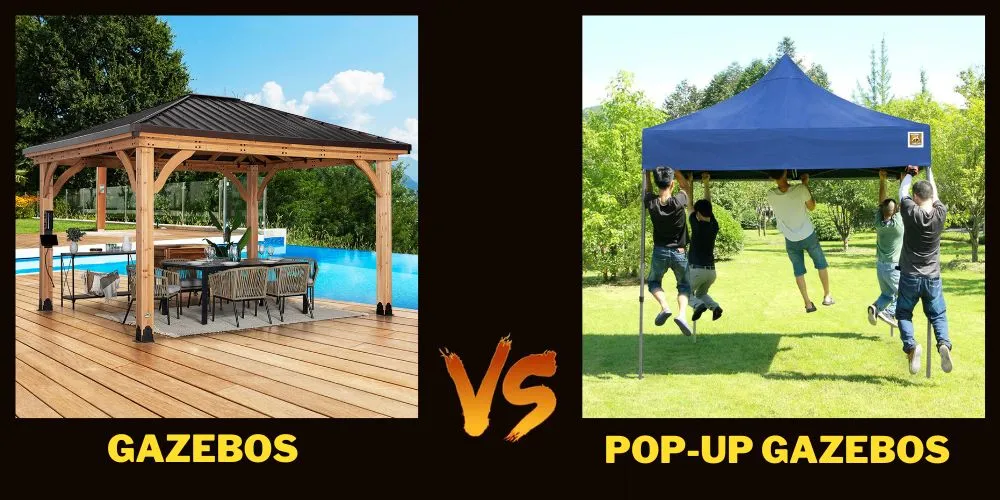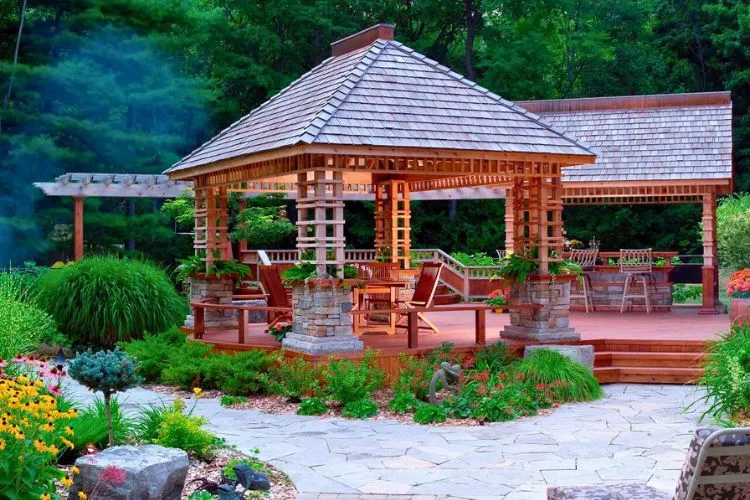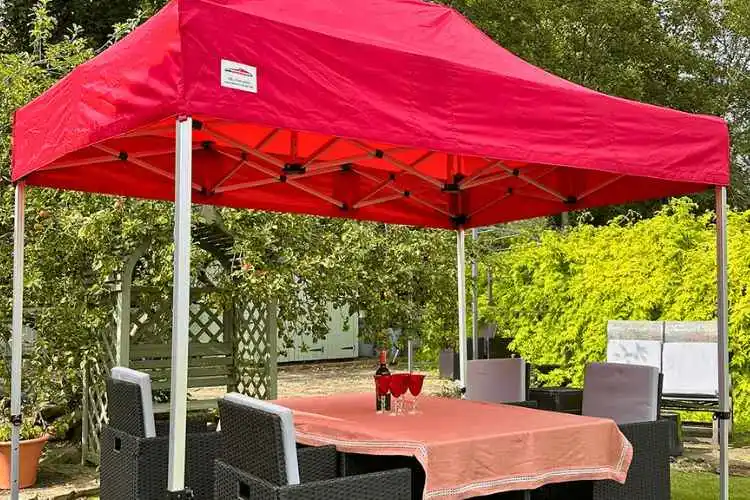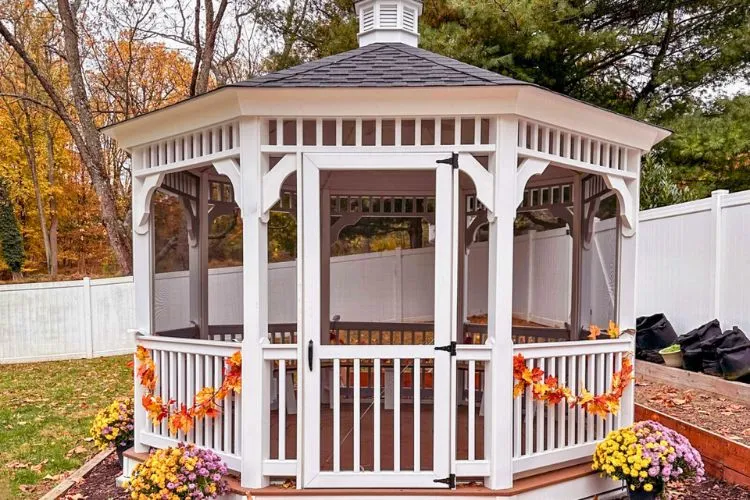Choosing between a gazebo and a pop-up gazebo for your outdoor space involves a number of considerations. From functionality and aesthetics to cost and installation time, each type offers distinct advantages and drawbacks.
This article delves into the details of traditional gazebos vs pop up gazebos, aiming to help you make an informed decision that best suits your needs and preferences.

Contents
- 1 Understanding Gazebos
- 2 Understanding Pop-up Gazebos
- 3 Gazebos vs Pop Up Gazebos
- 4 Choosing the Right Type for Your Needs
- 5 Pro Tips
- 6 Frequently Asked Questions (FAQs)
- 6.1 Can pop-up gazebos withstand strong winds?
- 6.2 Are traditional gazebos considered permanent structures for permitting purposes?
- 6.3 How do maintenance requirements differ between gazebos and pop-up gazebos?
- 6.4 Can either type of gazebo be fully enclosed for winter use?
- 6.5 Is it possible to install a traditional gazebo on any terrain?
- 6.6 Which is better, a gazebo or a pop-up gazebo?
Understanding Gazebos
Gazebos are permanent outdoor structures, often octagonal or circular in shape, that provide shade and shelter, serving as an elegant addition to gardens, parks, and backyards.

Traditional gazebos are made from various materials, including wood, metal, and vinyl, and are known for their durability and aesthetic appeal.
Pros of Gazebos
The main advantage of traditional gazebos is their durability. Being permanent structures, they are built to withstand varying weather conditions, providing a lasting outdoor retreat.
Additionally, gazebos add a touch of elegance to any space, with extensive customization options available to match your landscape. They can also increase the value of your property, making them a worthwhile investment.
Cons of Gazebos
On the downside, gazebos require a significant upfront investment. They also demand more time and expertise for installation, often needing professional help.
Once erected, their location is less flexible, limiting your ability to adapt your outdoor space over time.
Understanding Pop-up Gazebos
Pop-up gazebos are lightweight, portable shelters that can be easily assembled and disassembled, making them ideal for events, markets, and temporary outdoor gatherings.

They generally consist of a fabric canopy supported by a metal frame and are designed for convenience and ease of use.
Pros of Pop-up Gazebos
The key advantage of pop-up gazebos is their portability. They can be set up and taken down quickly, offering flexibility in use and location.
Pop-up gazebos are also more affordable, making them accessible for a wide range of budgets.
Their ease of assembly means you can have an outdoor shelter ready in minutes, without the need for specialized tools or skills.
Cons of Pop-up Gazebos
However, pop-up gazebos are typically less durable than traditional gazebos. They are not designed to withstand severe weather conditions and are more susceptible to wear and tear.
Additionally, pop-up gazebos offer limited customization options, which might not satisfy those looking to complement their outdoor decor precisely.
Gazebos vs Pop Up Gazebos
Aesthetics and Functionality
When it comes to aesthetics, traditional gazebos often have the upper hand, offering a classic look that enhances outdoor spaces.
They also provide a permanent shelter for year-round use. In contrast, pop-up gazebos cater to temporary needs, offering quick and convenient shade for occasional events.
Cost and Installation
Traditional gazebos are a larger investment, with costs encompassing materials, delivery, and professional installation. Pop-up gazebos, meanwhile, are more budget-friendly and can be set up by the user, eliminating installation costs.
Mobility and Versatility
The mobility of pop-up gazebos is unmatched. They can be moved easily to different locations or stored away when not in use.
Traditional gazebos, being permanent, lack this flexibility but offer a stable and enduring solution for those who don’t require mobility.
Maintenance and Durability
Gazebos require regular maintenance, including painting or staining, to maintain their appearance and longevity. Pop-up gazebos, made from fabric, need to be cleaned and checked for rips or damage, but generally involve less maintenance work.
Choosing the Right Type for Your Needs
When selecting the right gazebo for your outdoor space, consider the following:

- Outdoor Space and Use: Assess the size of your outdoor space and how you plan to use the gazebo. Permanent structures work well in large, settled landscapes, while pop-up gazebos are ideal for varied locations and events.
- Local Climate: Consider your local weather conditions. If you live in an area prone to harsh weather, a traditional gazebo might be more suitable.
- Budget: If cost is a major factor, a pop-up gazebo might be the way to go. It offers shelter without the significant investment required for a traditional gazebo.
You may also read: Canopy Vs Gazebo | Gazebo vs Pergola
Pro Tips
When choosing materials, opt for those best suited to your climate. For traditional gazebos, resistant woods or metals can withstand weather extremes. For pop-up gazebos, look for high-quality, waterproof fabrics.
If stability is a concern, especially for pop-up gazebos, consider using weights or anchors to secure the structure against wind.
Accessories such as curtains, nets, or lights can enhance both types of gazebos, increasing their functionality and aesthetic appeal.
Frequently Asked Questions (FAQs)
Can pop-up gazebos withstand strong winds?
Pop-up gazebos vary in their wind resistance. Securing them with weights or stakes can improve stability, but for high winds, dismantling the gazebo is often recommended.
Are traditional gazebos considered permanent structures for permitting purposes?
This depends on local regulations. Always check with your municipality to determine if a permit is required for your gazebo.
How do maintenance requirements differ between gazebos and pop-up gazebos?
Traditional gazebos require regular maintenance, such as painting or sealing, to protect against the elements. Pop-up gazebos need to be kept clean and dry, with fabric components stored properly to prevent mold and mildew.
Can either type of gazebo be fully enclosed for winter use?
Traditional gazebos can be enclosed, either permanently or with temporary panels, for winter use. Pop-up gazebos are less suited to winter conditions and are typically designed for seasonal use.
Is it possible to install a traditional gazebo on any terrain?
Installation of a traditional gazebo may require site preparation, including leveling and foundation work, to ensure stability and durability.
Which is better, a gazebo or a pop-up gazebo?
The choice depends on your needs. Traditional gazebos offer durability and an elegant look for permanent setups. Pop-up gazebos provide flexibility and are cost-effective for temporary outdoor shelter. Consider your space, budget, and how you plan to use it.
Conclusion:
Choosing between a traditional gazebo and a pop-up gazebo ultimately comes down to your specific needs, preferences, and budget.
By carefully considering the differences in aesthetics, costs, durability, and functionality, you can select the type of gazebo that will best enhance and serve your outdoor space.
Whether you opt for the permanence and elegance of a traditional gazebo or the flexibility and affordability of a pop-up gazebo, thoughtful selection will ensure your outdoor shelter meets your expectations and requirements for years to come.

Sergio Gomes, a passionate advocate for outdoor living and the male voice behind Shades Authority. With years of experience, Sergio is your trusted source for expert insights on gazebos, pavilions, cabanas, pergolas, and all things outdoor shade solutions. Join him on a journey to transform your outdoor spaces into stunning, functional retreats
